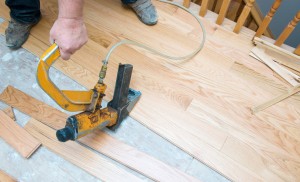Before you go forward with the final installation of your brand new hardwood flooring, take a moment to carefully examine the subflooring for any problems that could affect the installation and longevity of your floor. Subfloors should be clean, flat, and dry before the hardwood flooring starts to hit the floor. Here are common types of subflooring and their suggested uses.
Plywood and OSB Over Joists
These subfloors are common in newer homes with basements. They work well with any type of hardwood flooring, providing they have the proper thickness for OSB (23/32 inch minimum thickness). As joist spacing increases, the subflooring thickness needs to increase as well.
Concrete Slabs
Concrete is a common subfloor in homes that don’t have basements.
There are many ways you can install new hardwood flooring with concrete subflooring, including the following:
- Directly over concrete—solid wood flooring may not work below grade, but floating floors, engineered floors, and certain solid strip and parquet floors will install perfectly
- Over concrete with a wood subfloor—any hardwood works well for this
- Over concrete with a sleeper system—engineered wood flooring less than 3/4 of an inch thick or solid plank flooring wider than 4 inches will require wood subflooring over the sleepers. Solid strip or plank flooring can be laid directly on the sleeper system.
If you need to install a wood subfloor over the slab, you can use several methods including:
- Floating subfloor—two layers of 3/8” plywood laid without fastening or gluing them to the slab. The first layer is laid on the concrete subfloor and the second layer is glued or stapled on top
- Glue-down subfloor—5/8” or thicker plywood panels glued in a staggered pattern
- Nail-down subfloor—5/8” or thicker plywood panels fastened in 12” intervals on center and 6” intervals on the border
- Sleeper system –This system uses 2-by-4s spaced at 12 inch intervals
Older Subfloors
Solid Wood Subfloor
This type of subflooring is incredibly common in older homes. Dealing with a squeaky floor? Set protruding fasteners into the subfloor after you refasten it to the joists. If the subfloor is not usable as is, overlay it with ½-inch plywood. When laying over solid wood subfloor, make sure that you choose the right hardwood flooring. Parquet flooring, engineered flooring, or solid strip flooring thinner than half an inch may need another 3/8-inch layer of plywood to ensure maximum strength and durability.
Old Floor Covering
Working with older floors can be tricky whether they’re vinyl, linoleum, or wood. Before you consider removing flooring, do some research to ensure that no asbestos was used. Many pre-1950s homes have tiles containing asbestos and later homes (built through the 1970s) are still at risk. Contact a professional and have a sample tested before you rip everything up. If you skip this step and there is asbestos in the tiles, all work will be shut down until a professional abatement crew removes the old floor. In many cases, it is easier to put the new hardwood flooring directly over the old floor.
Make the Right Subflooring Choice
When you work with John K Eareckson & Co. Flooring, we will ensure you make the right subflooring choice for the beautiful hardwood flooring installed overtop. A great foundation will provide you with excellent flooring for years to come. For a consultation and more information visit us online or give us a call at 410-788-4200. You can also follow us on Facebook, Google+, Twitter, YouTube, and Flickr.


